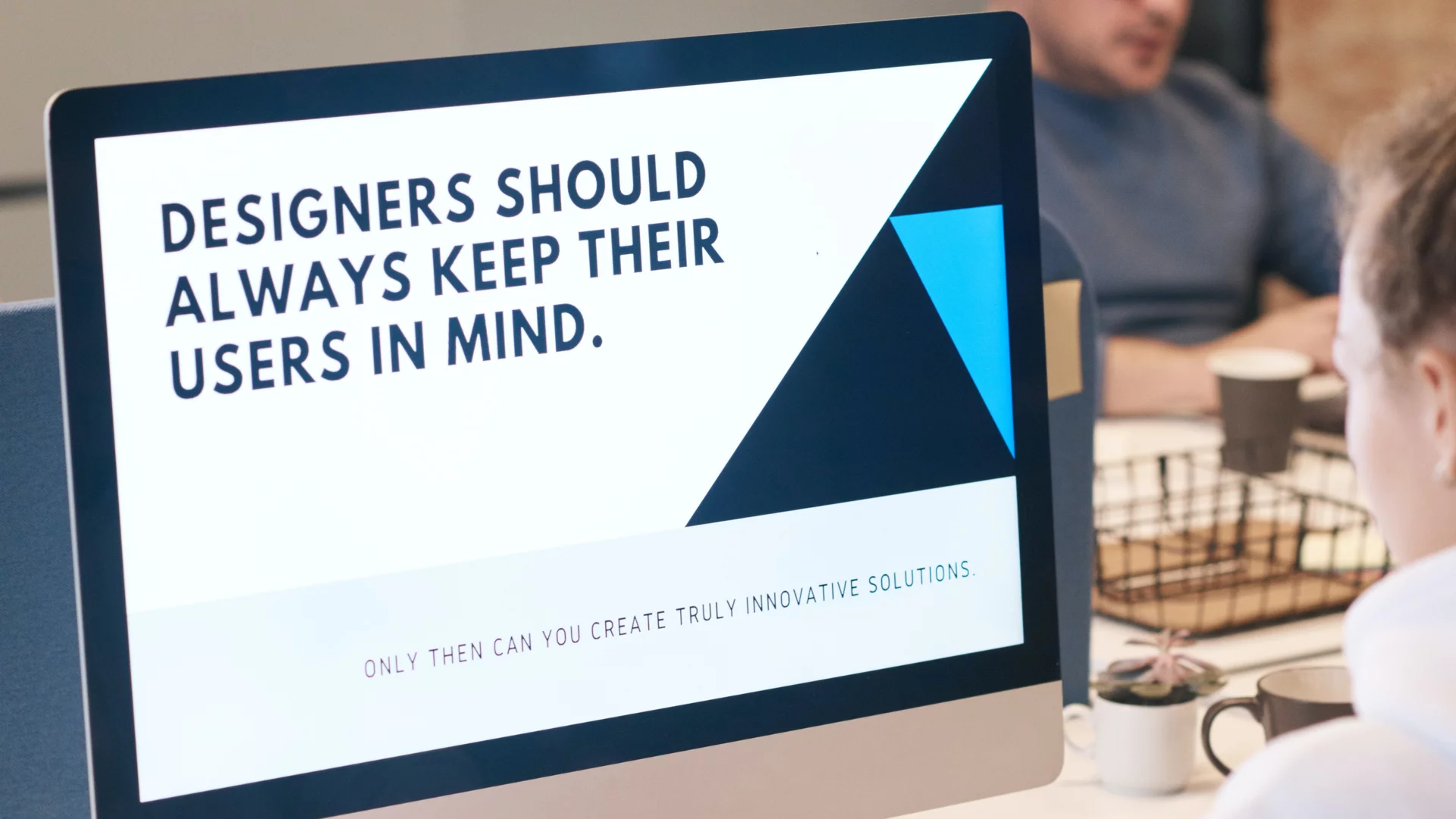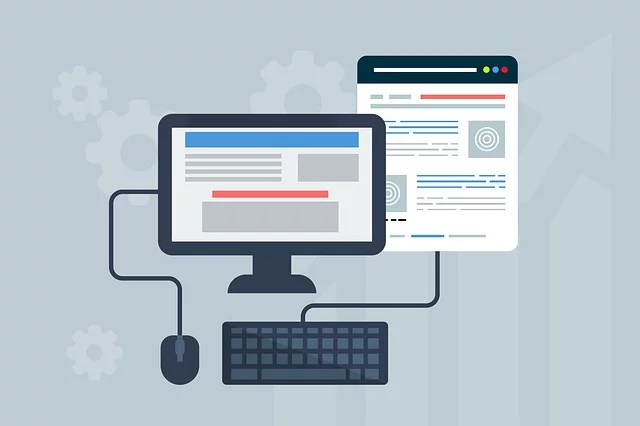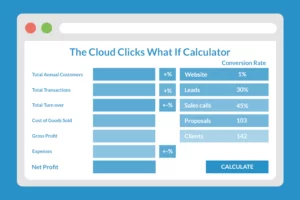In this digital interface era, web design plays a vital role in the online landscape. A convergence of functionality, aesthetics, user and page experience opens vast possibilities for the brand it embodies. This is where the role of a website designer becomes very significant.

Cloud Clicks is a web designing company specializing in this field, giving the website owners and brands the optimum performance for fast conversion and high ranking in the digital marketing competition that ranges from small businesses to large organizations.
This article will help you better understand web design as a marketing strategy and the importance of hiring the best web designer and a dedicated web design team for your business website. We will delve into the world of the web design industry, its essential principles, marketing solutions, and best practices that will aid website design company owners achieve their business goals
Key Principles of web design
An effective web design not only captivate users but also gives them the experience they expect as a visitor. To achieve these, we need to adhere to certain web design principles. This section will tackle the fundamental principles that comprise the backbone of an effective web design.
Visual design elements play a crucial role in capturing users’ attention and creating a memorable user experience. This includes the use of captivating imagery, compelling visuals, and an aesthetically pleasing layout. Web design professionals employ graphic design principles such as balance, contrast, and visual hierarchy to guide users’ attention to important elements, messages, and calls-to-action (CTAs).
Visual hierarchy
Visual hierarchy is a key principle in web design that involves arranging elements on a webpage to guide users’ attention and communicate the relative importance of each element. By establishing a clear visual hierarchy, a serious web designer or developer can effectively lead users through the content and highlight key information. Here are some important aspects of visual hierarchy:
Size and Scale: Larger elements naturally attract more attention. By increasing the size of important elements such as headings or key visuals, designers can make them stand out and draw users’ eyes.
Contrast and Color: The use of contrasting colors can create visual emphasis. By using bold or vibrant colors for important elements and more muted tones for secondary elements, designers can create a clear distinction and guide users’ attention accordingly.
Typography: Different font sizes, styles, and weights can be used to establish a hierarchy within the text content. Important headings can be larger and bolder, while body text is usually smaller and lighter.
Whitespace: It refers to the empty areas between elements. By strategically using whitespace, designers can create a sense of separation, prioritize content, and improve readability.
Alignment: Aligning elements deliberately can contribute to a sense of order and hierarchy. Whether it’s left-aligned, center-aligned, or right-aligned, consistent alignment enhances the visual flow and guides users’ attention.
Visual Cues: Designers can use arrows, icons, or other visual cues to direct users’ attention to specific elements or actions. These cues help users understand the desired path or actions on the webpage.
Color Theory
The main colors used in the website design building process must represent the brand promoted. Exploring the different psychological effects on its users and their impact on user’s emotions, perceptions, and, brand identity will help your website design company connect to its visitors.
Color Psychology: Different colors can evoke specific emotions and associations. For example, warm colors like red and orange can create a sense of excitement or energy, while cool colors like blue and green can evoke calmness or trust. A web developer considers the desired emotional response from users when selecting color palettes.
Branding and Consistency: A web developer ensures that the chosen color scheme aligns with the brand identity and conveys the desired brand personality. Consistency in color usage across the website helps reinforce brand recognition.
Color Contrast: Contrast is important for legibility and visual impact. A web developer considers color contrast to emphasize important elements and create visual interest.
Color Harmonies: Color harmonies refer to combinations of colors that work well together. A web designer uses these harmonies to create a visually pleasing and cohesive color scheme.
Typography
Ensure that the fonts used for your website design are readable and convey the proper tone that is related to your branding,
Typography plays a critical role in web design by enhancing readability, conveying information, and contributing to the overall aesthetic appeal. Here are some important considerations when it comes to typography:
Font Selection: Different font styles convey different tones and evoke different emotions. A web designer considers legibility, readability, and the desired brand personality when selecting fonts.
Font Pairing: Combining different fonts can create visual interest and hierarchy. The contrast in font styles can help differentiate between different levels of content.
Font Size and Hierarchy: Proper font sizing ensures readability and helps guide users through the content hierarchy. Headings and subheadings are usually larger and bolder to indicate importance, while body text is smaller and lighter.
Readability and Line Spacing: A web designer considers line spacing to ensure sufficient space between lines thus improving readability.
Responsive Typography: With the prevalence of mobile gadgets, a web designer ensures that typography adapts to different screen sizes and orientations.
Layout and Grid System
The layout and grid system are essential aspects of web design that help organize content, establish visual hierarchy, and create a cohesive structure. They provide a framework for arranging elements on a webpage and contribute to a visually pleasing and user-friendly experience. Here are important considerations when it comes to layout and grid systems:
Content Organization: A well-structured layout ensures that content is organized logically and intuitively. A web designer considers the flow of information, so users can easily navigate and locate the information they need.
Visual Hierarchy: Layouts and grid systems help establish a clear visual hierarchy by positioning elements in a structured manner. Designers use size, spacing, and placement to indicate the importance and relationship between different elements.
Grid Systems: They consist of columns, rows, and modules that guide the placement of content. A web designer utilizes grid systems to create consistency, improve readability, and maintain visual balance across different devices and screen sizes.
Responsive Design: With the rise of mobile gadgets, responsive design has become crucial. Web designers ensure that websites are optimized for various devices, allowing for a consistent and user-friendly experience across desktops, tablets, and smartphones.
Whitespace and Margins: Whitespace, also known as negative space, is the space between elements. It provides breathing room, enhances readability, and contributes to a clean and uncluttered design.
Accessibility
Accessibility in web design refers to the practice of creating websites and designing an existing website so that it will be usable and accessible to all individuals, including those with disabilities. An accessible website ensures that people with visual, auditory, cognitive, or physical impairments can perceive, understand, navigate, and interact with the content effectively.
Mobile Responsive

Mobile responsiveness is the practice of designing and building websites to provide an optimal user experience across different devices and screen sizes. It ensures that websites adapt and function seamlessly on smartphones, tablets, and other mobile gadgets. Here are important considerations for mobile responsiveness:
Responsive Design: Web designers adopt responsive design techniques to ensure that websites built automatically adjust their layout, content, and functionality based on the screen size and orientation of the device being used. This includes adapting font sizes, image sizes, and navigation elements to ensure readability and usability.
Touch-Friendly Elements: Buttons and navigation menus should be large enough to accommodate finger taps and interactive elements should be spaced adequately to prevent accidental touches.
Simplified Navigation: Mobile screens have limited space, so navigation menus need to be simplified and streamlined.
Optimized Performance: Web designers optimize performance by minimizing file sizes, optimizing images and media, and employing caching techniques to ensure fast load times.
Testing and User Experience: Web designers conduct thorough testing on various mobile devices and screen sizes to ensure a seamless user experience. This includes checking for readability, usability, and functional compatibility across different mobile platforms and browsers.
A web design that focuses on intuitive navigation, user-friendly interface, and clear information. Icons and buttons must clearly state their function so that users can easily navigate and find what they need.
Navigation and usability are critical aspects of web design that influence how users interact with a website. Effective navigation ensures that users can find information easily, while usability focuses on creating an intuitive and user-friendly experience. Here are key considerations for navigation and usability:
Clear and Consistent Navigation: Navigation menus should be clearly labeled and placed prominently on the website to ensure that users can easily locate and access different sections or pages.
Intuitive Menu Structure: Web designers create logical and intuitive menu structures that reflect the website’s content hierarchy. Grouping related pages or sections and using descriptive labels help users understand the website’s structure and find the information they need efficiently.
Search Functionality: Incorporating a search feature allows users to quickly find specific information or products. Search boxes should be easily accessible, prominently placed, and provide accurate and relevant search results.
User-Friendly Forms: Web designers optimize form design to enhance usability. This includes using clear instructions, labeling form fields effectively, providing real-time validation, and minimizing the number of required fields.
Error Handling and Feedback: Effective error handling and feedback mechanisms inform users about any errors or issues encountered during form submissions or other interactions.
User Testing and Iterative Improvement: Web designers conduct user testing to gather feedback on navigation and usability. Through testing, designers can identify pain points, understand user behavior, and make iterative improvements to enhance the overall user experience.
Loading speed optimization
A delay in page response can attribute to a 7% decrease in conversion. Implementing techniques so that site speed performance is optimized and minimizes loading times. Take note that a slow loading website will discourage users from exploring deeper into the multiple pages of your website content.
Website speed and performance directly impact user experience and conversions. Slow-loading websites frustrate users and increase bounce rates. Web design professionals optimize website performance by minimizing file sizes, leveraging caching techniques, and optimizing code. They also ensure that the website is hosted on a reliable and fast server.
By prioritizing page speed and performance, businesses can create a seamless browsing experience that keeps users engaged and encourages them to take desired actions.
Compelling Call-to-Actions (CTAs)
Effective CTAs and lead generation forms play a crucial role in driving conversions. Web design professionals strategically place prominent CTAs throughout the website, using contrasting colors and persuasive copy to draw attention and encourage action.
Well-designed forms and CTAs guide users toward desired actions, such as making a purchase, subscribing to a newsletter, or filling out a contact form.
User experience in Web design

Use experience is a critical aspect that must be given with utmost importance as it has a direct impact on the user’s satisfaction and conversion rates.
In this section, we will delve into the principles of user experience in web design.
User research
Understanding user behavior, preference, and needs by implementing research methods such as surveys, interviews, and usability testing.
Wireframing and Prototyping
An effective website developer creates interactive prototypes, app development, and skeletal framework to visualize, refine and make improvements in a a website project’s functionality.
Informative architecture
Informative architecture, also known as information architecture, refers to the organization, structure, and presentation of information within a system or a website. It focuses on arranging and labeling content in a way that enables users to find and understand the information easily and efficiently.
The goal of informative architecture is to create a logical and intuitive structure that helps users navigate through the content, locate relevant information, and achieve their goals.
Interactive Design
A web design that is intuitive and interactive by incorporating animations and transitions. Ensure that these designs will not hinder or distract users from navigating the website.
Animations and transitions add a layer of interactivity and delight to web design. They can be used to guide users, highlight important elements, and create a more engaging experience.
However, it’s important to use animations and transitions judiciously, ensuring they enhance the user experience without causing distractions or slowing down the website’s performance.
Incorporating Social Media Integration
Social media integration allows businesses to extend their online presence and engage users on various social media accounts and platforms. Web design professionals incorporate social media sharing buttons, live feeds, and social media account integration to encourage users to connect, follow, and share content.
Social proof, such as displaying user-generated content or testimonials, enhances credibility and fosters trust among visitors. By leveraging social media integration, businesses can amplify their reach, encourage user engagement, and drive conversions.
E-commerce Websites and Online Stores
For businesses selling products or services online, creating an engaging and conversion-driven e-commerce website is crucial. Web design professionals focus on providing their ecommerce websites with an intuitive and streamlined shopping experience, with clear product categories, detailed product descriptions, high-quality product images, and a secure and user-friendly checkout process.
Feedback and iteration
To gain insight into user experience, collect feedback information and implement strategies based on the insight provided to improve overall user experience.
New Website? Follow these Web design best practices

Developing websites is a huge task that entails ensuring the success of a web design project. To achieve this goal, it is vital to research and implement the web design industry’s best practices.
In this section, we will explore key considerations and tips for a new website designer to follow.
Mobile first approach
In today’s digital landscape, mobile users are the main source of website traffic. A custom design website that is user-friendly for all types of mobile gadgets must be given priority. Your website’s search ranking can, and often is, affected by the quality of your website build.
Responsive images and media
To enhance performance and adaptability across various devices, optimizing media and image files is a must.
SEO-friendly design( Search engine optimization )
To improve ranking and website visibility, incorporating search engine optimisation in the web design process should be implemented.
Cross-browser compatibility
Testing and ensuring that your website renders correctly and performs at an optimum level across different web browsers.
Consistency and Branding
Establishing consistency in the embodiment of the brand’s visual identity while closely aligning the design with the brand’s guidelines.
Scalability and Future-Proofing
Web designing with scalability to future growth and technological advancements.
Collaborating with Web Design Professionals: Harnessing Expertise for Successful Website Projects
In the digital landscape, collaborating with web design professionals is essential for Adelaide businesses aiming to create impactful websites that drive results. Web design professionals bring a wealth of knowledge, expertise, and industry best practices to the table, ensuring the successful execution of website projects.
There are so many benefits to partnering with a top website design company, web design company, or a web design company or agency that can build you a website.
Let’s explore the key aspects of collaborating with other web design companies, and professionals and how their involvement can contribute to the overall success of your web design venture.
Choosing the Right Web Design Agency in Adelaide
Selecting the right web design agency is a critical step in the collaboration process. It’s important to conduct thorough research, review portfolios, and consider client testimonials to evaluate the agency’s capabilities and expertise. Look for agencies with experience in your industry or niche, as they will have a better understanding of your target audience and specific requirements.
Working with Web Designers and Developers
Web design agencies typically have teams of designers and developers who work collaboratively on website projects. Designers focus on the visual elements, including layout, color schemes, typography, and branding, while developers handle the technical aspects such as coding, functionality, and database integration.
Establishing a collaborative workflow ensures that your vision is translated into a well-designed and functional website. This essentially allows you to actively participate in the shaping and refining of your website project.
Dedicated Project Management and Communication
A crucial aspect of collaborating with leading web design company and professionals is having a dedicated web project manager who oversees the entire process. The project manager acts as a liaison between you the dedicated project manager and the leading web design company and team, ensuring that timelines are met, milestones are achieved, and communication flows smoothly.
`They provide regular project updates, address any concerns or questions, and coordinate feedback from stakeholders. Effective communication channels, such as regular meetings or using project management tools, facilitate transparency and enable all parties to stay informed and engaged.
Maximizing Customer Satisfaction and Feedback
A website designer understands the importance of customer satisfaction and strives to create websites that align with your goals and vision. They encourage open dialogue and actively seek feedback throughout the website design process. By sharing your preferences, goals, and expectations, you enable
designers to make informed decisions and tailor the website to your unique requirements.
Evaluating Results and Continuous Improvement
Collaboration with a professional website designer extends beyond the initial website launch. It involves monitoring website performance, analyzing user behavior, and making data-driven decisions to optimize the website over time.
Web design professionals utilize analytical tools to track website metrics, such as user engagement, conversion rates, and bounce rates. They provide insights and recommendations for ongoing improvements to enhance the user experience, increase conversions, and adapt to evolving industry trends.
Collaborating with a professional website designer in Adelaide is essential for businesses seeking to create successful websites. Their expertise, industry knowledge, and collaboration skills contribute to the overall success of your new website design project.
Understanding Your Business
In the digital era, an exceptional, website design is a powerful tool for large and small businesses to gain a competitive edge and reach the target audience effectively. Website design encompasses various elements including visual aesthetics, functionality, user experience, and search engine optimization.
By prioritizing a user-centric approach to web project, collaborating with experienced website design professionals, and embracing digital marketing strategies, businesses can create captivating websites that drive customer engagement, conversion, and business growth.
With the right web design strategy, small businesses in Adelaide can establish a strong online presence, build brand credibility, and forge lasting connections with their audience.
Digital Marketing and Web Design Synergy: Amplifying Online Success

In today’s digital landscape, the synergy between digital marketing and web design plays a crucial role in the success of online businesses. Website design sets the foundation for a visually appealing and user-friendly website, while digital marketing strategies drive targeted traffic, increase conversions, and boost brand visibility.
Let’s delve into the key aspects of this synergy and how it can amplify the online success of large and small businesses.
Aligning Web Design with Marketing Strategies
Web design should align with the overarching marketing strategies of a business. A cohesive and consistent brand experience across all digital platforms is essential. Web design professionals collaborate with digital marketers to ensure that the web design elements, such as colors, typography, and imagery, reflect the brand identity and resonate with the target viewers.
Rank well in search engines with SEO and Web Design
Web design and SEO go hand in hand. An SEO-friendly website structure and optimized search engines and content contribute to better search engine rankings and increased organic traffic. Web design professionals collaborate with SEO specialists to implement proper heading tags, meta descriptions, and URL structures.
SEO-based web design ensures the site is fast-loading, mobile, and user-friendly, all of which are key factors considered by Google search engines in determining search rankings. One of the most important criteria when choosing a web designer Adelaide and a new website or company is to ensure the new website that is built with effective on-page SEO.
Google Ads and Pay-Per-Click (PPC) Campaigns
Effective web design enhances the performance of Google Ads and PPC campaigns for large and small business websites. Landing pages and conversion-focused design elements, such as compelling call-to-actions (CTAs) and intuitive navigation, improve the user experience and increase the chances of conversions.
Web design professionals collaborate with digital marketers to optimize landing pages for maximum conversions, aligning design elements with specific campaign objectives.
Leveraging Social Media and Content Marketing
Web design and content marketing are closely intertwined. Web design professionals collaborate with content creators to ensure seamless integration of engaging and shareable content into the website’s design.
This includes incorporating social media sharing buttons, displaying user-generated content, and creating visually appealing blog layouts. The web design should encourage social media engagement and provide an immersive experience for users consuming content.
Tracking Website Traffic and Analytics
Web design professionals work closely with digital marketers to implement website tracking tools, such as Google Analytics, to monitor and analyze user behavior, traffic sources, and conversion rates.
By collaborating on tracking and analytics, they gain valuable insights into user engagement, identify areas for improvement, and optimize the web design and content based on data-driven decisions. This synergy ensures continuous refinement of the website’s performance and user experience.
The synergy between digital marketing and web design is crucial for amplifying online success. By aligning web design with marketing strategies, businesses can create a consistent and engaging brand experience for their target audience
Cloud Clicks: Your Web design Adelaide Partner

Need professional web development or design done WordPress website? We are a digital marketing and web design company that takes care of everything from content writing and graphic design to imagery and icons.
Our web design Adelaide company specializes in building websites that convert viewers into paying clients by visually communicating your brand to a limitless audience. As a leading web design company, we recognize the significance of these updates and the impact they can have on your website’s ability to rank.
We utilize scalable platforms that provide a range of features and functionalities to support your online store. Our Web Design Adelaide team will fully optimize your website for mainstream desktop, tablet, and mobile devices.
In contrast to other web design companies, our web design team and service delivery manager will work closely with you to discuss strategy development, implementation, and evaluation of your next web design strategy and development project.
We have proven the good standing of our service by positive feedback from our clients. Experience a successful web design project, book with us today.
FAQS about web design
What is web design?
The creation of your new website, is then started by our skilled web designer. . Web design process is the process of conceptualizing, planning, and implementing a web design concept that is functional and offers an outstanding user experience.
How long will it take to build websites?
In the web design industry, the timeline for the completion of building g website project generally takes from two to six months. It will also depend on whether the web designer and the client agree that they are both satisfied with the result.
What are Ecommerce Websites?
An e-commerce website is a virtual place where a seller and buyer can transact their business through an online store. Customers can browse your e-commerce website and purchase your product without needing to go to your physical store. All transactions can be accomplish online using your mobile device or desktop.
What are WordPress Websites?
WordPress is a content management system where you can create, manage and host a website easily. It is totally free to use, but it can also charge you once you decide to use upgraded features for your WordPress website. It is highly versatile and can be used to create various types of websites, including blogs, business websites, portfolios, online stores, membership sites, and more.
Its user-friendly nature, extensive customization options, and abundant resources make it a popular choice for individuals, small businesses, and organizations looking to establish an online presence quickly and efficiently.
What is a Content Management System (CMS)?
CMS is a software application that allows users to create, manage, and modify digital content on a website without requiring advanced technical knowledge. It provides a user-friendly interface and a set of tools that simplify the process of creating, editing, organizing, and publishing content on the web.
Overall, content management systems simplify the process of web content creation and management, empowering users to maintain dynamic and engaging websites without significant technical expertise.






